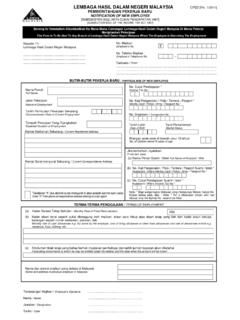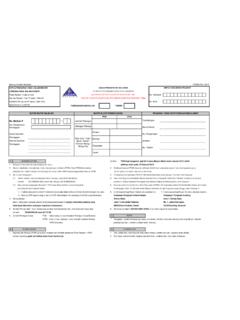Transcription of Riparian Buffer CP22 Conservation Plan (ver 2/07) Natural ...
1 Riparian Buffer CP22. Conservation plan (ver 2/07). Natural Resources Conservation Service (NRCS). Definition A Riparian forest Buffer is an area of trees and shrubs located adjacent to streams, lakes, ponds, or wetlands. Purpose Riparian forest buffers of sufficient width intercept sediment, nutrients, pesticides, and other materials in surface runoff and reduce nutrients and other pollutants in shallow subsurface water flow. Woody vegetation in buffers provides food and cover for wildlife, helps lower water temperatures by shading the stream or waterbody, and slows out-of-bank flood flows. In addition, the vegetation closest to the stream or waterbody provides litter fall and large wood important to fish and other aquatic organisms as a nutrient source and structural components to Buffers are located along or around permanent or increase channel roughness and habitat complexity.
2 Intermittent streams, lakes, ponds, wetlands, or Also, the woody roots increase the resistance of seeps. Many of these areas feature year-round or streambanks and shorelines to erosion caused by seasonal moisture, which allows woody species to high water flows or waves. Some tree and shrub establish quickly. A new Riparian forest Buffer can species in a Riparian forest Buffer can be managed for rapidly benefit a variety of settings, such as cropland, timber, wood fiber, and horticultural products. rangeland, forest land, and urban areas. Where used Pasture Cro ps Zone 3. Herbaceous Zone 2 Zone 2. or grass filter Zone 1 Zone 1. strip Ma naged forest Stream of fast-growing Ma naged forest introduced or of fast-growing native species introduced or Native species if available;. native species little or no tree harvesting; water- loving or water-tolerant species A Riparian forest Buffer includes a zone 1, the area closest to the stream or waterbody, and a zone 2, the area adjacent to and up gradient of zone 1.
3 Trees and shrubs in zone 1 provide important wildlife habitat, litter fall for aquatic organisms, large wood that can fall into the stream or waterbody, and shading to lower water temperature. This zone helps stabilize streambanks and shorelines. Trees and shrubs in zone 2 (along with zone 1) intercept sediment, nutrients, pesticides, and other pollutants in surface and subsurface water flows. Zone 2 can be managed to provide timber, wood fiber, and horticultural products. A third zone, zone 3, is established if periodic and excessive water flows, erosion, and sediment from upslope fields or tracts are anticipated. Zone 3. generally consists of herbaceous plants or grass and a diversion or terrace, if needed. This zone provides a first line of defense to assure proper functioning of zones 1 and 2. Job Sheet Riparian Forest Buffer (391) Revised 2007. Page 1 of 6. local laws will be followed.
4 Spot treatment must be Resource management system authorized by FSA during the primary nesting season Riparian forest buffers are normally established for wildlife. If mechanical cultivation is used, cultivate concurrently with other practices as part of a resource at a shallow depth to avoid harming tree/shrub roots. management system for a Conservation management unit. For example, adjoining streambanks or Haying and grazing of the Riparian Buffer is not shorelines must be stabilized before or in conjunction allowed. Livestock must be excluded. Control animal with the establishment of the Buffer (streambank and damage by rodents, mice, rabbits, deer, gophers, shoreline protection). To maintain proper functioning beaver and other wildlife as needed. The contract of a planting, excessive water flows and erosion must acreage will be protected from damaging fire. be controlled upslope of the Riparian forest Buffer (filter strip, diversion, critical area planting, residue The Riparian Buffer will be inspected for soil erosion, management).
5 New plantings must be protected from gullies and sediment deposition following severe grazing during establishment (prescribed grazing, use storms or at least on an annual basis. Concentrated exclusion). flow must be converted to sheet flow or subsurface flow before entering Zone 2 or the Buffer . Repair any Required management activities areas disturbed or damaged using soil material from outside the Buffer and re-vegetate areas that do not To ensure continued stand vigor and health, wildlife have permanent cover. benefits and plant diversity, management activities are required for this practice. Refer to Conservation Do not use contract area for field roads, turn rows or Reserve Program Forest Management Activities for other uses detrimental to the cover. Avoid spray drift guidance on this requirement. when treating nearby or adjacent crop or pasture fields. Specifications Site-specific requirements are listed on the specifications sheet.
6 Additional provisions are entered on the job sketch sheet. Specifications are prepared in accordance with the NRCS Field Office Technical Guide. See practice standard Riparian Forest Buffer , code 391. Wildlife Connecting Riparian forest buffers with existing perennial vegetation benefits wildlife, including fish and other aquatic organisms. Existing buffers may be woodlots and wooded draws or other woody habitats such as windbreaks or shelterbelts. Select tree and shrub species and a planting pattern that benefits the wildlife species of interest and enhance local landscape aesthetics. Operation and maintenance Replace dead and dying woody species in newly established plantings. Trees and shrubs in a Riparian forest Buffer can eventually become crowded, slowing their growth and the growth, survival, and composition of understory species. As the Buffer matures, periodic harvesting of some of the overstory trees and shrubs becomes an important activity for maintaining plant health and Buffer function.
7 Some of the older trees that are dead or dying within the Buffer area can serve as nesting cavities for terrestrial organisms as well as a source of large woody debris for aquatic systems. Undesired vegetation such as grass or weed competition, noxious weeds and invasive species will be controlled through the life of the contract. In controlling undesired vegetation state regulations and Job Sheet Riparian Forest Buffer (391) Revised 2007. Page 2 of 6. Riparian Buffer Conservation Practice Job Sheet CP22. Landowner_____ Field number_____. Purpose (check all that apply). Create shade to lower water temperature to improve aquatic habitat. Provide detritus and large woody debris for aquatic and terrestrial organisms. Remove nutrients, sediment, organic matter, pesticides and other pollutants from surface runoff and subsurface flow to reduce pollution and protect surface water and subsurface water quality.
8 Layout Water body/course type and name, other: Minimum Buffer zone widths (ft) specify left and right of stream [facing upstream/downstream (circle appropriate one)] for a two-side Buffer ; use left only for water bodies, such as lakes and ponds; include herbaceous species in zone 3 notes or refer to other jobs sheets. The minimum acceptable width of zones 1 and 2 must be the lessor of 100 feet or 30% of the geomorphic floodplain. The maximum average width (zones 1-3) is 180 ft for any purpose other than protection and enhancement of water quality. NRCS or the TSP must document in writing to the ARC the need for a minimum design specification in excess of 180 feet (average width). Zone 1 (Must be = or > 15ft wide) Zone 2 (Avg. =or > 20ft wide) Zone3 (NTE 20 ft in width). Left: Right: Left Right: Left: Right: Notes: Notes: Notes (or refer to other job sheets): Add ineligible land between the water body and eligible land to the overall width of the Riparian Buffer (ft): Buffer zone length (ft): Additional location and layout requirements: Additional Requirements (such as watering facilities, fencing, grazing plan , etc.)
9 : Woody Plant Materials Information 1 2. Species/cultivars: Plants/acre Kind of stock : Planting dates: Avg. Spacing : : Zone # 1. 1. 2. 3. 4. Zone # 2. 1. 2. 3. 4. Zone # 3. 1. 2. 3. 4. 1. BAreroot, COntainer, CUtting, Seed; include size, caliper, height, and age as applicable. 2 Spacing between plants to achieve plants/acre. Job Sheet Riparian Forest Buffer (391) Revised 2007. Page 3 of 6. Planting Methods For container and bareroot stock, plant stock to a depth even with the root collar in holes deep and wide enough to fully extend the roots. Pack the soil firmly around each plant. Cuttings are inserted in moist soil with at least 2 to 3 buds showing above ground Additional Requirements: Temporary Storage Instructions Planting stock that is dormant may be stored temporarily in a cooler or protected area. Pack the soil firmly and water thoroughly. For stock that is expected to begin growth before planting, dig a V-shaped trench (heeling-in-bed).
10 Sufficiently deep and bury seedlings so that all roots are covered by soil. Additional Requirements: Site Preparation Remove debris and control competing vegetation to allow enough spots or sites for planting and planting equipment. Additional Requirements: Natural Regeneration Document that adequate seed sources of approved tree, shrub and grass species are present in the soil at the site. Tree Species Shrub Species Grass Species (Zone 3 only). 1 1 1. 2 2 2. 3 3 3. 4 4 4. Document that under normal conditions, the appropriate cover will be established within 2 years of the CRP-1 effective date: Noxious weeds, invasive species and other undesirable plants, insects and pests will be controlled. Additional Requirements: Required Management Activities Refer to the fact sheet Conservation Reserve Program Forest Management Activities for information about required mid-contract management activities for this practice.












